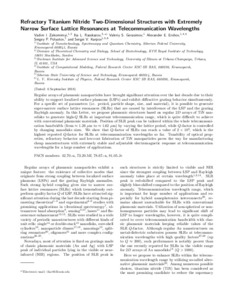Titanium nitride nanoparticles as an alternative platform for plasmonic waveguides in the visible and telecommunication wavelength ranges
Скачать файл:
URI (для ссылок/цитирований):
https://www.sciencedirect.com/science/article/pii/S1569441017303462#!https://elib.sfu-kras.ru/handle/2311/111325
Автор:
Zakomirnyi, V. I.
Rasskazov, I. L.
Gerasimov, V. S.
Ershov, A. E.
Polyutov, S. P.
Karpov, S. V.
Ågren, H.
Коллективный автор:
Институт нанотехнологий, спектроскопии и квантовой химии
Дата:
2018Журнал:
Photonics and Nanostructures - Fundamentals and ApplicationsКвартиль журнала в Scopus:
Q2Квартиль журнала в Web of Science:
Q3Библиографическое описание:
Zakomirnyi, V. I. Titanium nitride nanoparticles as an alternative platform for plasmonic waveguides in the visible and telecommunication wavelength ranges [Текст] / V. I. Zakomirnyi, I. L. Rasskazov, V. S. Gerasimov, A. E. Ershov, S. P. Polyutov, S. V. Karpov, H. Ågren // Photonics and Nanostructures - Fundamentals and Applications. — 2018. — Т. 30.Текст статьи не публикуется в открытом доступе в соответствии с политикой журнала.
Аннотация:
We propose to utilize titanium nitride (TiN) as an alternative material for linear periodic chains (LPCs) of nanoparticles (NPs) which support surface plasmon polariton (SPP) propagation. Dispersion and transmission properties of LPCs have been examined within the framework of the dipole approximation for NPs with various shapes: spheres, prolate and oblate spheroids. It is shown that LPCs of TiN NPs support high-Q eigenmodes for an SPP attenuation that is comparable with LPCs from conventional plasmonic materials such as Au or Ag, with the advantage that the refractory properties and cheap fabrication of TiN nanostructures are more preferable in practical implementations compared to Au and Ag. We show that the SPP decay in TiN LPCs remains almost the same even at extremely high temperatures which is impossible to reach with conventional plasmonic materials. Finally, we show that the bandwidth of TiN LPCs from non-spherical particles can be tuned from the visible to the telecommunication wavelength range by switching the SPP polarization, which is an attractive feature for integrating these structures into modern photonic devices.

